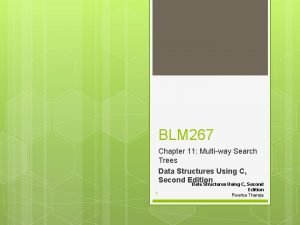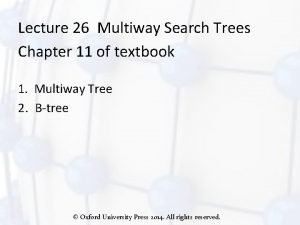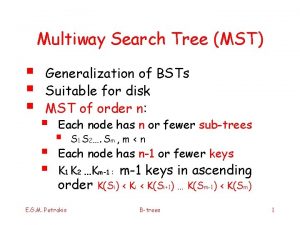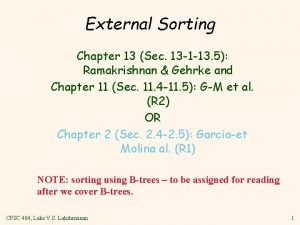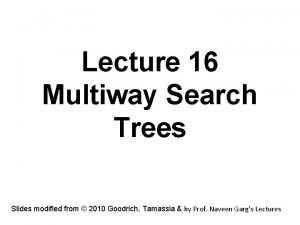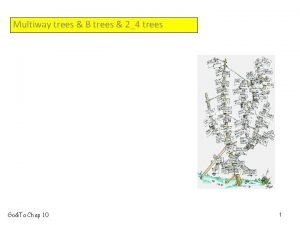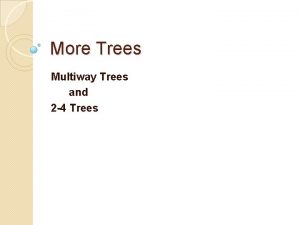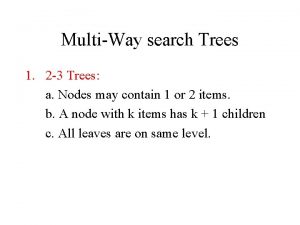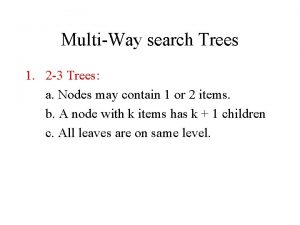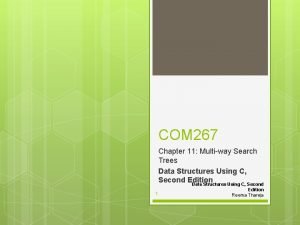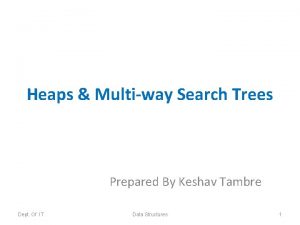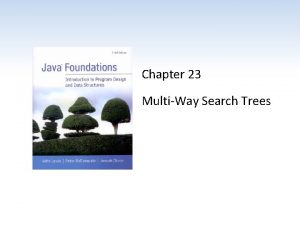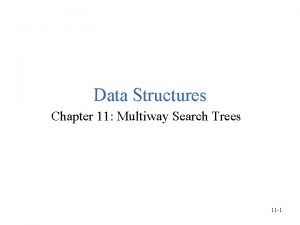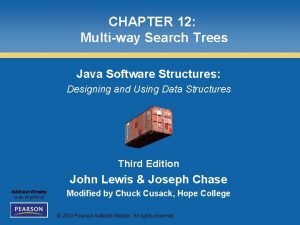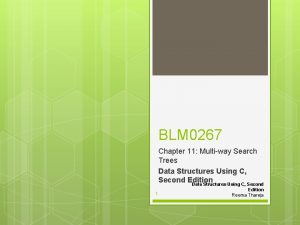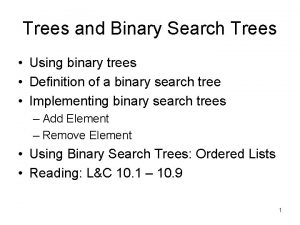Lecture 16 Multiway Search Trees Slides modified from

































- Slides: 33

Lecture 16 Multiway Search Trees Slides modified from © 2010 Goodrich, Tamassia & by Prof. Naveen Garg’s Lectures

Ordered Maps So far • List/Array • BST • AVL Tree

Lets try multiple children… 30 25 40 50 75

Multiple keys at each node! 30 50 25 40 75

How many keys do we need at a node to have d-way search tree? d-1

Confusion Points 1. nodes 2. keys 3. children

Multiway search tree with degree d! • internal nodes have at least 2 children and at max d children • each node stores upto d-1 items

In-order traversal of multiway tree 30 50 25 29 14 20 26 27 40 75 80

Search 12

Search 24

What is the time complexity of search in a d-way search tree?

O(h*log d)

2 -4 Tree • a node can have 2 to 4 children • all leaf nodes are at the same level

Search complexity? O(h)

Min & Max height (h)?

Minimum number of entries? h+1 n≥ 2 -1 h≤log 2(n+1)-1

Maximum number of entries? h+1 n≤ 4 -1 h≥log 4(n+1)-1

2 -4 Tree Height log 4(n+1)-1 ≤ h ≤ log 2(n+1)-1 1/2 log 2(n+1) ≤ h+1 ≤ log 2(n+1) O(log n)

Insert

Case 1: Node has empty space 21 23 29 40 7 13 22 32 18 3 8 10 1 2 4 5 6 9 11 12 14 15 25 20 24 35 26 28 30 33 37 39

Case 2: node is already full 29 split the node 7 13 22 32 18 3 8 10 1 2 4 5 6 9 11 12 14 15 25 20 21 23 24 35 26 28 30 33 37 39 40

Promote one key to the parent! 7 13 22 32 18 3 8 10 1 2 4 5 6 9 11 12 14 15 25 20 21 35 33 23 24 26 28 29 30 37 39 40

Promote one key to the parent! Split the parent! 13 22 32 18 3 8 10 1 2 9 4 5 6 7 11 12 14 15 25 28 20 21 35 33 23 24 26 29 30 37 39 40

Eventually, we may have to create a new root! 5 13 3 22 32 8 10 18 1 2 9 4 6 7 11 12 14 15 25 28 20 21 35 33 23 24 26 29 30 37 39 40

Complexity of insert? • O(log n) to find the node • O(log n) node splits in the worst • Node split takes constant time o(log n)

Delete

Claim: We always delete key in the leaf node! • Delete 25 13 5 3 22 8 10 18 1 2 9 4 6 7 11 12 14 15 25 28 20 23 24 26 29 30

Case 1: leaf node has at least 2 keys • Delete 21 13 5 3 22 8 10 18 1 2 9 4 6 7 11 12 14 15 25 28 20 21 23 24 26 29 30

Case 1: leaf node has at least 2 keys • Delete 25 13 5 3 22 8 10 18 1 2 9 4 6 7 11 12 14 15 25 28 20 23 24 26 29 30

Case 2: leaf node has only 1 key • Delete 20 • borrow from 13 sibling 5 3 22 8 10 18 1 2 9 4 6 7 11 12 14 15 24 28 20 23 26 29 30

What if sibling has only 1 key? • Delete 23 • Merge siblings 13 5 3 22 8 10 24 28 15 1 2 9 4 6 7 11 12 14 18 23 26 29 30

What if the parent has only 1 key? • Delete 18 • Cascaded merge 13 5 3 22 8 10 28 15 1 2 9 4 6 7 11 12 14 18 24 26 29 30

2 -4 Trees • The height of a (2, 4) tree is O(log n). • Search, insertion and deletion each take O(log n). • Pretty fundamental to the ideas of advanced trees such as Red-Black trees.
 Multiway trees
Multiway trees 3 way search tree
3 way search tree Multiway search tree
Multiway search tree Two way selection and multiway selection
Two way selection and multiway selection Two way selection and multiway selection in c
Two way selection and multiway selection in c Multiway selection flowchart
Multiway selection flowchart Multiway trie
Multiway trie Mapreduce شرح
Mapreduce شرح Two phase multiway merge sort
Two phase multiway merge sort Pentaho multiway merge join
Pentaho multiway merge join A small child slides down the four frictionless slides
A small child slides down the four frictionless slides Each of the boxes shown is pulled for 10 m
Each of the boxes shown is pulled for 10 m Principles of economics powerpoint lecture slides
Principles of economics powerpoint lecture slides Machine learning lecture
Machine learning lecture Business communication lecture slides
Business communication lecture slides 01:640:244 lecture notes - lecture 15: plat, idah, farad
01:640:244 lecture notes - lecture 15: plat, idah, farad Ternary search trees
Ternary search trees Binary search trees
Binary search trees Blind search algorithm
Blind search algorithm Federated search vs discovery
Federated search vs discovery èinterest
èinterest Federated search vs distributed search
Federated search vs distributed search Informed and uninformed search
Informed and uninformed search Https://tw.images.search.yahoo.com/images/view
Https://tw.images.search.yahoo.com/images/view Best first search in ai
Best first search in ai Heuristik
Heuristik Yahoo gravity
Yahoo gravity Twvideos
Twvideos Disadvantages of algorithm
Disadvantages of algorithm Linear search vs binary search
Linear search vs binary search Http://search.yahoo.com/search?ei=utf-8
Http://search.yahoo.com/search?ei=utf-8 Multilingual semantical markup
Multilingual semantical markup Which search strategy is called as blind search
Which search strategy is called as blind search 1http
1http
